Most of us sit in flexion all day hunched over a computer screen or slouched in our car. This causes poor posture and often poor extension, which can lead to improper movement patterns, compensations and eventually pain and injury.
That is why it is important to include Extension Exercises in our workouts. These exercises open us up after sitting in flexion all day.
And one of the more important areas to include Extension Exercises for is our Spine. Proper Thoracic Extension is important not only for proper posture, but also to prevent neck, shoulder, upper back, lower back and even hip pain.
If you don’t have proper Thoracic Extension, your body is going to take the path of least resistance and seek out extra extension from other areas – areas that may not have the ability to provide the extension needed and therefore become overworked and injured. This compensation can lead to injuries up and down your body.
That is why it is important that you included exercises to improve your Thoracic Extension in your workouts.
Below are some great Thoracic Extension Exercises, including the Thoracic Bridge. Include these in your workouts, warm ups or even throughout the day at your desk.
Thoracic Extension Exercises
While it is tempting to only work on the area right around the pain or injury and, while it is tempting to just focus on your spine since that is the area lacking flexion, you won’t solve the problem if you don’t think about your body as a connected system.
Many of the exercises you need to include to improve your Thoracic Extension don’t actualy work on your back or spine.
Actually a huge reason you may lack Thoracic Extension is because your chest is tight. So these moves will address many of the areas of tightness that perpetuate your forward flexion.
Some of these exercises will also strengthen the muscles of your back to help you maintain the Extension and mobility that you do develop. No one move alone will solve your problem. You must included Foam Rolling, Stretching, Activation and Strength Training in your workout routine.
Foam Rolling Moves
The first step to improving your Thoracic mobility and extension is to roll out all the muscles that get tight from sitting in flexion for most of the day. That means you really need to focus on rolling out and loosening up your chest and lats.
You can also use the roller, and even the Peanut, to help start improving your Thoracic Extension by allowing your spine to extend.
Chest Foam Rolling – A tight chest is not only caused by sitting hunched over a computer all day, but also perpetuates your rounded posture and spinal flexion. If your chest is tight, there is a chance that your Thoracic Extension may be limited.
To roll out your chest, you can use a larger foam ball against the ground or a smaller ball against the wall in a doorway. The smaller ball in the doorway can dig in a little bit more if you can handle the extra firmness and pressure.
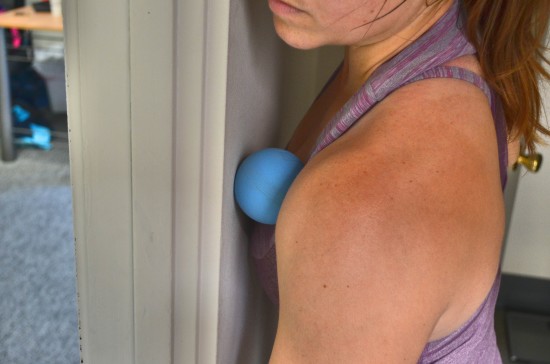
To roll out your chest against a wall in a doorway, stand facing the wall besides the doorway and place the ball between your chest and the wall just inside your shoulder at the edge of your chest below your collarbone. Make sure you are right on the edge of the wall so that you can extend your arm forward through the doorway.
Then press into the ball by leaning forward into the wall and raise the arm on the side you are digging into up toward the ceiling and then back down. Because you are in the doorway, you can raise your arm straight out in front of you to lift the arm very slowly up toward the ceiling and then lower it back down toward the ground. Hold on any tight spots you find as you move your arm.
You can then move the ball along the muscles below your collarbone and even down around your shoulder joint toward your armpit. Hold on any tight spots you find and even lift and lower your arm.
Then switch and roll out the other side.
Lat Foam Rolling – Tight lats can also perpetuate your rounded posture and prevent proper thoracic mobility. They can cause you to overuse the small muscles of your shoulder and even create compensations and imbalances because your body will seek out extension from other areas that aren’t meant to be used in that way.
To roll out your lats, you can use a small ball or a roller. A roller works best unless there is a specific spot you want to target.
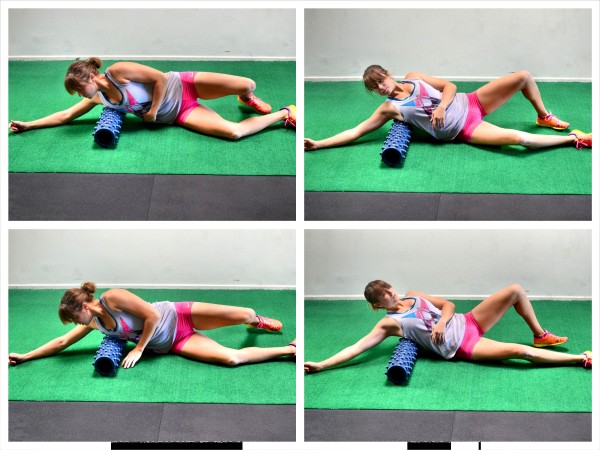
To use the roller, lie on your side with the roller under one armpit. Rotate your chest slightly open so the roller is hitting the side of your back. Extend that bottom arm up overhead.
Then rotate your chest toward the ground and then up toward the ceiling, rocking on the roller to dig out the side of your back, hitting forward toward your ribs and then back toward your back.
Hold on any tight spots you find then move the roller lower down the side of your back. Hold on any tight spots as you go and make sure to rock forward and backward as you make your way down your side.
As you work down your side, you may want to rotate slightly more toward your back. Work all the way from your armpit to about the end of your rib cage.
Roller Thoracic Extension – The foam roller can be a great tool to not only loosen the muscles that can restrict your thoracic mobility, but to actually put your thoracic spine through extension. The Roller Thoracic Extension is a great move to roll out your back as you work on your extension.
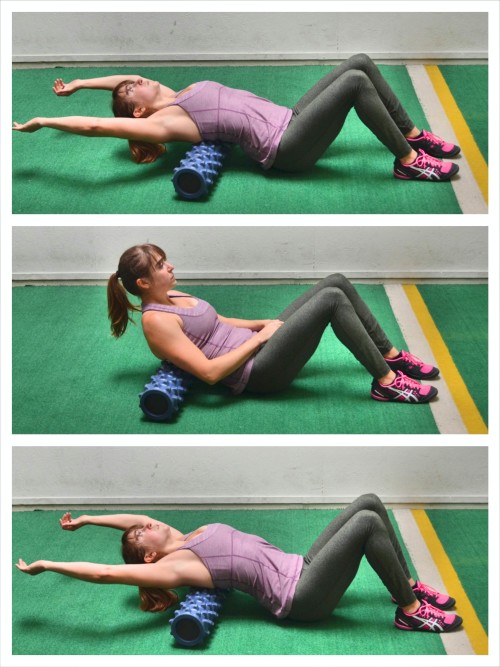
To do the Roller Thoracic Extension, lie back over a roller on the ground with the roller at about your mid-back. You do not want to do this move with the roller in your low back or you could hyperextend your low back.
With the roller in your mid-back, cross your hands over your chest and, keeping your butt on the ground, extend your back over the roller, relaxing back over the roller. As you extend back over the roller, reach your arms overhead and relax your head and neck.
Try to touch the backs of your hands to the ground behind you without lifting your butt up off the ground. Do not simply arch your low back to extend over the roller. Focus on extending your mid and upper back over the roller.
Then sit back up, crossing your hands back over your chest. You can then move the roller up your back or keep it in the same place and repeat, relaxing and extending back over the roller as you reach your arms back overhead.
Perform the extension a few times, especially if the area feels tight, and work your way up your back. Each time you extend over, keep your butt on the ground. Hold for a second or two as you extend so that you can breathe and relax more over the roller.
Work all the way up your mid to upper back. Do not do this on your lower back.
Peanut Thoracic Extension – A great way to really release and relax the muscles along your spine while putting your spine through extension is with the Peanut Thoracic Extension.
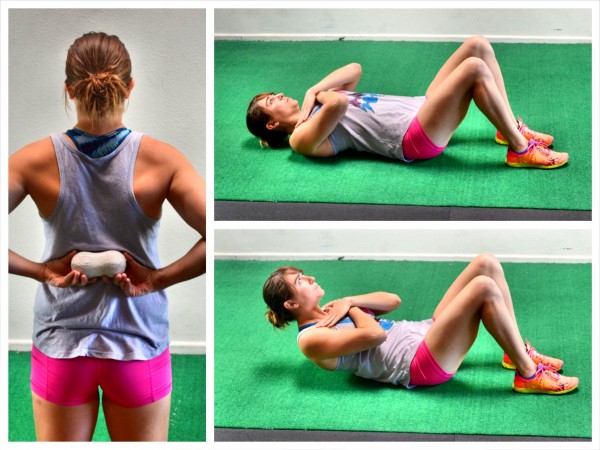
To use the Peanut to improve your Thoracic Extension, you will place the Peanut in your mid-back while lying on your back on the ground with a ball of the peanut on each side of your spine.
Bend your knees and place your heels on the ground. Then cross your hands over your chest and relax back over the Peanut. Relaxing over the Peanut, extend your arms up overhead.
Then crunch your upper body up, tensing the muscles of your back. Do not crunch up off the Peanut. You simply want to tighten the muscles before you relax back over the Peanut.
By “crunching up” and contracting the muscles, you can help the muscles release when you relax back over the Peanut.
As you work up your back, moving the peanut up toward your shoulders, perform a few crunches and extensions in each spot. As you relax over each time, reach your hands overhead or even make “snow angels” with your arms, sweeping them along the ground and overhead before bringing them back down by your sides and finally back across your chest.
Stretching Exercises
Once you’ve started loosening up tight muscles by foam rolling, you’ve got to begin to really focus on stretching those muscles to improve your extension. These stretches will loosen tight muscles caused by sitting in flexion for most of the day and will even start to put your spine through extension.
Standing Chest Stretch – The Standing Chest Stretch is a great way to stretch your chest, shoulders and bicep. It can help open everything up after sitting hunched over a computer for long hours. Opening everything up will help improve your Thoracic mobility and extension.
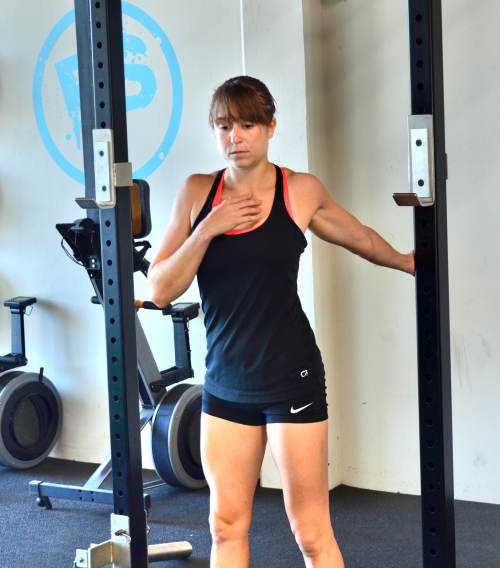
To do the Standing Chest Stretch, you can use a doorway, wall or pole. Place one hand on the edge of a doorway and walk past it, turning away from the hand that is back.
Rotate your chest away from the hand on the door to feel a stretch through your chest, shoulder and bicep. Do not shrug your shoulder. Relax and breathe as you rotate away.
You can open up your chest and shoulder more by changing the direction that your thumb is pointing. If you rotate your thumb and palm up away from the way, you will hit your chest from a different angle than if your palm is facing the wall.
Hold the stretch and try to rotate more open as you hold. This is a great stretch to do throughout the day!
Half Wall Hang – A great stretch for your lats that will also work on your Thoracic Extension is the Half Wall Hang. With this stretch, you’ve got to make sure to focus on extending your upper and mid back as you relax over. It is very easy with this stretch to simply extend your low back instead of your Thoracic spine, especially if your Thoracic Extension is limited, so really focus on keeping your abs engaged as you extend.
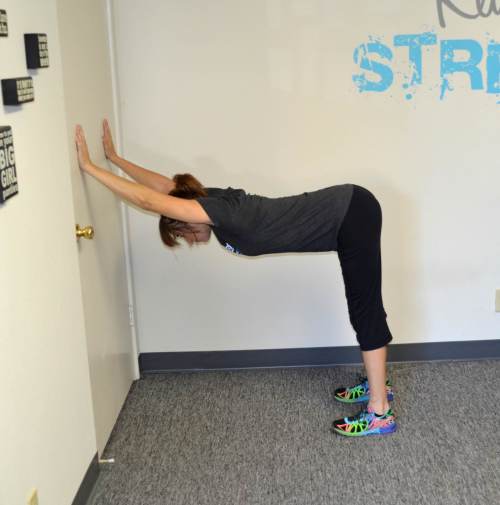
To do the Half Wall Hang, stand facing a wall and then place your hands on the wall as you walk your feet back and even move your hands down the wall until your chest is parallel to the ground. You should walk your feet back and set your hands up on the wall so that you are hinging over with your hips bent to about 90 degrees and your legs straight.
As you hang over with your hands on the wall, try to extend your back with your arms straight and your biceps by your ears. Try to extend your spine and create a nice straight line from your hands on the wall to your tailbone.
Press your chest out toward the ground as you extend your spine. Drive your chest through your arms and feel a nice stretch through your lats and triceps. You really want to feel a stretch down the sides of your back and even through your ribs and arms.
Hold and breathe and focus on extending your Thoracic spine as you keep your abs engaged so you don’t hyperextend your low back.
Beginners may need to start with their hands higher up on the wall and their feet closer in so that they aren’t leaning over as much.
Kneeling Thoracic Extension and Lat Stretch – A great variation of the Half Wall Hang to also stretch your lats and improve your Thoracic Extension is the Kneeling Thoracic Extension and Lat Stretch. This is a great move to keep your shoulders healthy and even stretch your triceps.
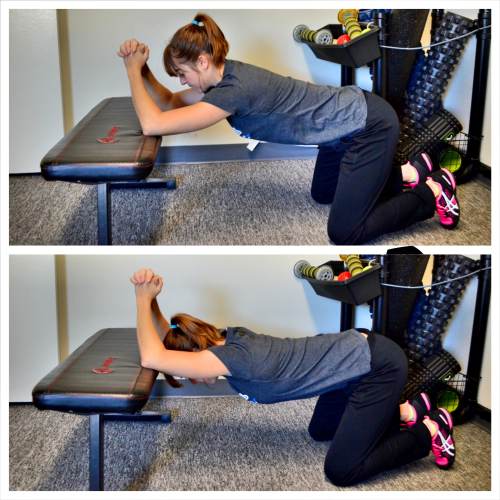
To do the Kneeling Thoracic Extension and Lat Stretch, kneel in front of a bench or box and place your elbows up on the bench about shoulder-width apart. Kneel far enough from the bench that you have room to sit back and drop your chest through your arms to extend your spine.
Then with your elbows on the bench, sit your butt back and relax your chest and head over, pressing your chest toward the ground so that you feel a nice stretch down your triceps and lats as well as through your thoracic spine. Try to extend your back as much as possible as you drop your chest toward the ground between your arms. Try to get your biceps by your ears as you extend your spine.
You can either hold here and breathe, relaxing deeper into the stretch as you hold or you can perform repetitions, trying to stretch further each time you repeat the stretch.
Camel – Camel is another great stretch for your anterior chain and can help open up your chest, shoulders, biceps and even your hips. It can also stretch your quads a bit as well as your abs. It is basically the opposite of what you do all day seated at your desk – it is extension to all of that flexion.
And while we may be talking about Thoracic mobility and extension that doesn’t mean you should only focus on your upper body. Everything is connected, which means that tight hips could also be effecting how your spine and, even your upper body, functions. That is why it is important to include stretches such as the Camel.
Plus the Camel stretch provides the added bonus of activating your glutes!
You can do the Camel as a static stretch or as a bridge for repetitions.
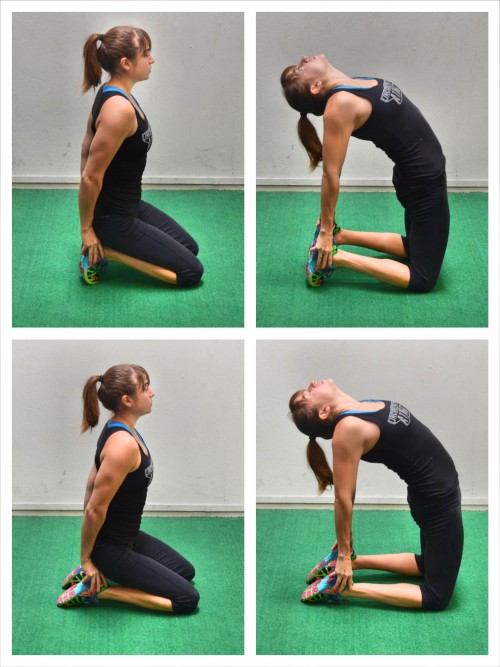
To do the Camel stretch, start kneeling with your knees about hip-width apart and your feet flexed. If you point your toes, it will increase the stretch. Sit back on your heels and place a hand on each heel.
Then with your hands on your heels, arch your hips up and away, extending your hips as you lift your glutes up off your heels and pressing your chest out. Really squeeze your glutes to fully extend your hips, but make sure you aren’t simply arching your low back to bridge up.
Relax your head back and really press your chest out as you open your shoulders up so that you get a nice stretch across your chest and shoulders as well as through your core, hips and quads. Do not shrug your shoulders.
If you are doing this as a bridge, hold for 1-2 seconds and then sit back on your heels. Repeat, arching back up.
You can also make this a static stretch by simply holding the pose for 15-20 seconds at the top of the bridge.
If you are less flexible, you can do this stretch with a couch, chair or table behind you so that you don’t have to reach and place your hands on your heels.
Activation Exercises
After stretching out tight muscles that may limit your Thoracic Extension, you need to get the proper muscles activated and working. If you don’t get the big muscles of your back activated and working properly, you won’t be able to retain the mobility and flexibility you’ve gained from foam rolling and stretching.
Often when we have injuries or limitations, we are great about stretching and rolling, but not about activating. We go right from stretching and rolling to our strength training workouts. But if we never actually learn how to engage and activate the correct muscles, we are going to end up with the same issues.
That is why Activation Exercises are such an essential part of improving your Thoracic extension and mobility!
Activation exercises will get the big muscles of your back working and strengthened through your new range of motion and extension.
Thoracic Bridge – The Thoracic Bridge is a great way to work on the mobility of your spine. And not only does it work on extension but also rotation. It will strength and activate your entire posterior chain while it helps stretch and improve your mobility.
You can do the Thoracic Bridge with a Sit Thru if you want to make the move more challenging and really improve your core strength and mobility; however, it does require more mobility and strength so only attempt it after mastering the Basic Thoracic Bridge.
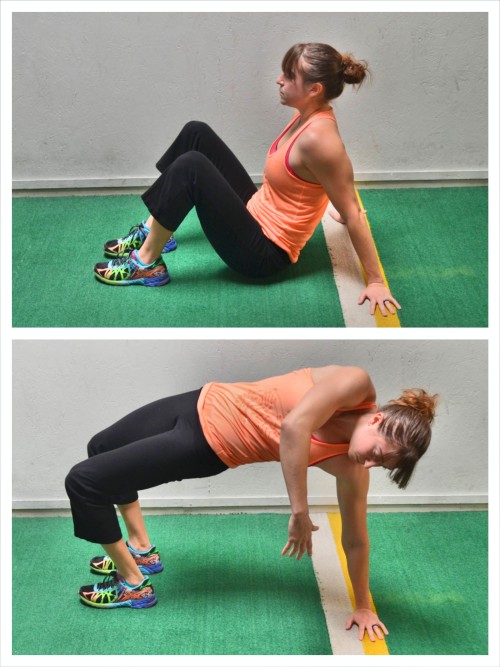
To do the Basic Thoracic Bridge, start seated on the ground with your knees bent and feet flat on the ground in front of you and your hands on the ground behind you. Then driving through your hands and feet, bridge up, lifting your butt up off the ground as you extend your hips and press your chest up and out.
Fully extend your hips as you squeeze your glutes and keep your abs braced. Bridge up so that you create almost a “table” with your body. As you bridge and hold at the top, lift one hand up off the ground and reach it across your body.
Keep your hips up as you reach across your body and toward the ground. Rotate your spine to really reach toward the ground as you keep both your hips up. You are twisting almost like someone wringing out a towel.
Make sure to squeeze your glutes at the top and extend your hips. Don’t simply try to get up higher by hyperextending your low back. Then drop your hips and place your hand back down on the ground behind you.
Bridge back up and lift your other hand up and across your body to reach toward the ground. Again keep both hips up as you twist your spine to reach toward the ground. Lower back down and repeat, alternating reaches.
Scapular Wall Hold – Another great activation move for your back is the Scapular Wall Hold. It activates your lower traps and rhomboids while working to reverse the flexion you sit in all day at your desk. Plus it helps open up your chest as you hold and activate your back.
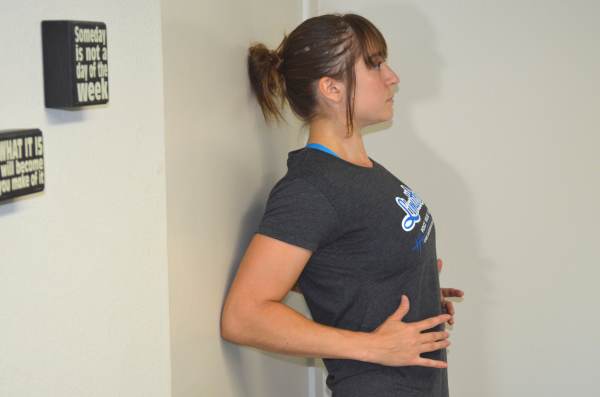
To do the Scapular Wall Hold, stand facing away from the wall with your arms down by your sides and your elbows bent to about 90 degrees. Then lean back and drive your elbows back into the wall as you press your chest out and open toward the ceiling. Only your elbows should touch as you lean back and press your chest out.
Engage your abs and glutes to keep your body in a nice straight line as you lean back. Draw your shoulder blades together and feel your back working as you press your chest out and open toward the ceiling. Do not shrug your shoulders or tuck your chin as you hold and feel your back working.
You can walk your feet out further from the wall to make the move harder, but really focus on feeling it between your shoulder blades no matter how far you walk out.
If you don’t feel the muscles between your shoulder blades and even down the sides of your back working and instead feel your neck, walk your feet closer to the wall. You don’t need to have your feet really far out from the wall to feel this move working. If you do it correctly, you can even feel it working when standing basically straight against the wall.
Wall Slides – Wall Slides are also a great activation and mobility exercise to improve your Thoracic Extension. They can also be a great way to test your extension and see it progressing as you work on it using these moves.
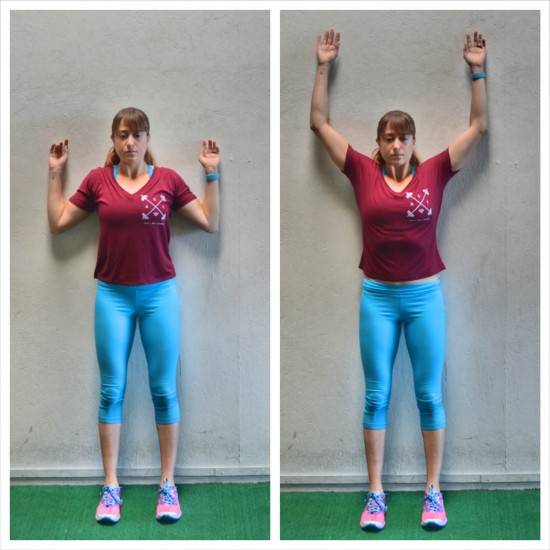
To do Wall Slides, lean your back against the wall with your feet a few inches from the wall. Bend your knees slightly and press your back into the wall, making sure your low back isn’t arching off. At no point through the movement should you allow your low back to arch.
Press your upper back into the wall and relax your head against the wall as you bend your arms and place the back of your hands against the wall right outside your head.
Keeping your back firmly against the wall and your core tight, slide the back of your hands up the wall as far as possible. Then slowly slide them back down.
Don’t slide them up further if your low back is arching off the wall and you are getting the extension from your low back instead of your upper back.
Repeat, reaching up the wall and each time try to get higher up the wall.
Scapular Band Flyes – Improving your scapular mobility is an important part of reversing your rounded posture, strengthening your back and improving your Thoracic Extension. That is why it is important to include Scapular Band Flyes in your routine. This move will activate your back and work on your scapular retraction.
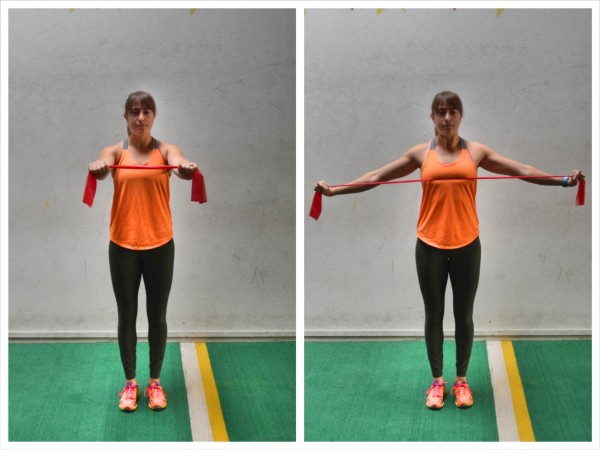
To do Scapular Band Flyes, hold a resistance band in both hands with your hands about shoulder-width apart and your palms facing the ground. Hold in closer to make the move harder, but just make sure you can perform the Fly without shrugging your shoulders or bending your arms. Stand tall and press your chest out as you raise your arms up straight in front of you at about shoulder height. Keep your neck and shoulders relaxed and do not shrug.
Then keeping your arms straight and up at about shoulder height, pull out on the band to open your arms out to the sides as you bring the band in toward your chest. Pinch your shoulder blades down and together as you fly your arms open and stretch the band. Do not let your shoulders shrug up as you pull the band. Feel your back working and your shoulder blades drawing together.
Hold with your arms open for a second or two and feel your back working. Then bring your arms back together so your arms are about shoulder-width apart again or closer. Make sure that when you bring your arms back in front of you there is still tension in the band.
Then repeat the fly. Do not let the band pull you or let your elbows bend as you fly your arms open.
Posterior Plank – The Posterior Plank is another great activation and stretching exercise. It will open up your anterior chain as it activates your backs and glutes.
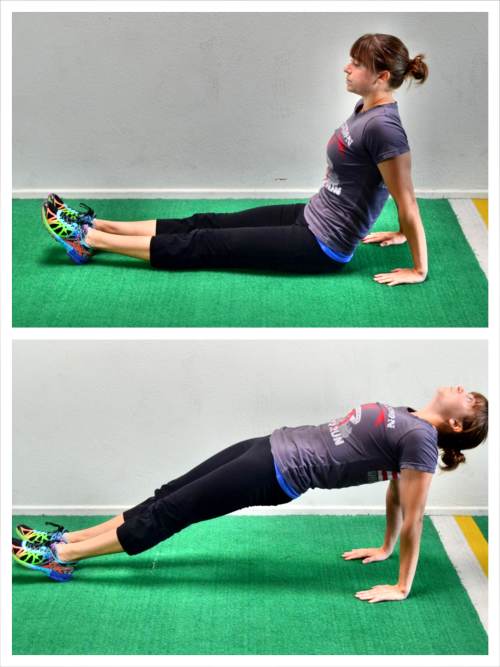
To do the Posterior Plank, sit on the ground with your legs out straight in front of you and your hands on the ground behind your butt. Place your feet together and point your fingertips toward your butt or out toward the sides.
Then, driving through your hands and heels, bridge up, extending your hips as you raise your butt up off the ground and press your chest out. Keep your legs straight as you press your chest up and extend your hips.
Relax your head back as you pause at the top and squeeze your glutes. Keep your abs braced and your body in a nice straight line as you hold.
Then lower back down and repeat the Posterior Plank. Really feel your chest opening up and your glutes and back working as you bridge up.
Strengthening Exercises
Once you’ve worked to stretch, mobilize and activate, you then need to focus on really building strength in the big muscles of your back.
A strong back means less risk for neck, shoulder and back injuries. It also means better posture aka not rounded forward in flexion. And it will help you maintain proper Thoracic Extension.
Inverted Row – The Inverted Row is a great way to strengthen your back and improve your scapular retraction to help maintain proper Thoracic Extension. It is a great way to also strengthen your back to improve your Pull Ups.
You can do the Inverted Row off a bar of using a Suspension Trainer.
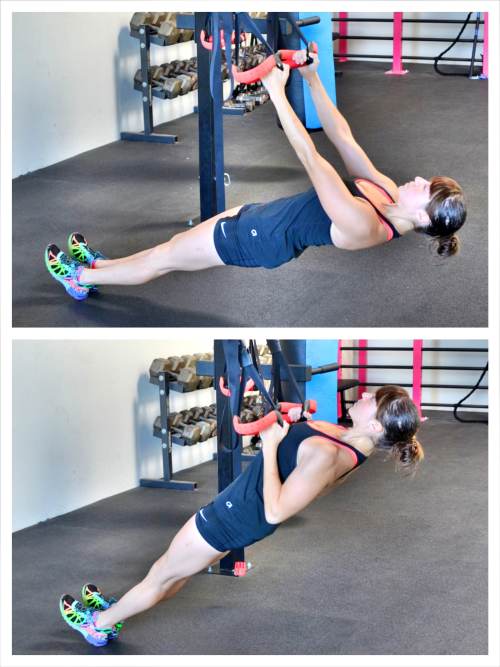
To do the Inverted Row using a Suspension Trainer, hold a handle in each hand with your palms facing in toward each other (you can vary your grip and even have your palms facing you or facing the ground). Walk your feet forward so that your body is at an incline. The closer to parallel to the ground you get, the harder the move will be.
With your body in a nice straight line and your chest pressed out, row your chest up to the handles, driving your elbows down and back. Engage your core and glutes and keep your legs straight. You want a nice straight line from your head to your heels as you row. Do not let your low back arch or your hips sag toward the ground. Keep your wrists straight as you row up and do not shrug your shoulders.
Then lower back down, keeping your body in a nice straight line. Do not lose tension at the bottom. Make sure to keep your chest pressed out and core engaged. Do not swing to row back up.
Make sure to feel your back and arms working to row and not just your arms. Focus on feeling your back pull and do not shrug your shoulders. Think about driving your elbows down and back as you row. Even at the bottom of the row feel your back engage to initiate the pull.
Back Flyes – Strengthen your upper back, improve your scapular retraction and even strengthen your posterior deltoid using the Back Fly.
Many of the movements we do throughout the day, and the exercises we include in our workouts, strengthen the fronts of our shoulders and our chest, pulling us into flexion. That is why the Back Fly, which not only strengthens our back but also the backs of our shoulders, is an important move to include to help reverse the forward flexion.
To do Back Flyes, you can use a Suspension Trainer or Dumbbells.
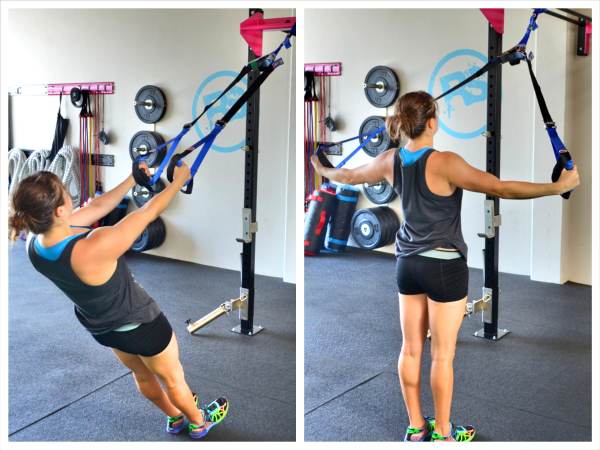
To do Back Flyes using the Suspension Trainer, hold a strap in each hand and walk your feet forward toward the anchor point. The close to parallel your body is, the harder the move will be. You will not want to walk them as far forward as you do with the Inverted Row.
Then keeping your body in a nice straight line from your head to your heels, fly your arms open and out to the side. Feel your back pull your arms open as you pull your body up. Feel your shoulder blades pinching together and make sure your shoulders don’t shrug. You may fly your arms open and slightly down to make sure you don’t shrug your shoulders. Keep your elbows soft, but do not bend your arms as you open to the side. Do not turn this into a row.
Pull yourself up so that your arms are even with your body and then lower back down, bringing your hands back together. Keep your arms straight as you bring your hands back together in front of you. Do not arch your back or swing your body to help yourself get all the way up. If you can’t fly your arms all the way open, walk your feet back so that you are more vertical instead of closer to parallel to the ground. Do not let your hips sag or arch as you perform the fly.
Squeeze your glutes and keep your abs engaged to keep your body in a nice straight line as you perform the fly. Make sure you don’t shrug your shoulders as you open. Keep your chest pressed out as you perform the fly. Move slowly and don’t bounce off the bottom. Focus on squeezing your shoulder blades down and together as you perform the Back Fly.
Lat Pull Downs – Strengthening your lats and improving your scapular retraction will also help reverse the flexion and even improve your Thoracic Extension. Lat Pull Downs are a great way to build your back and lat strength while also working on your scapular retraction. Plus they will help improve your Pull Ups!
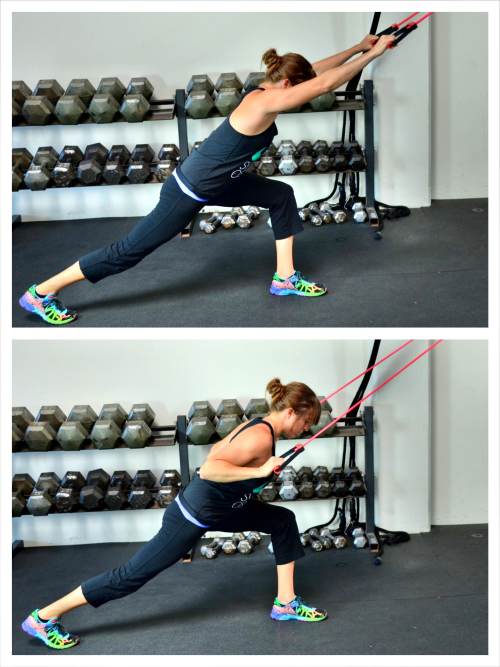
To do Lat Pull Downs, you can use a machine or even resistance bands. Using a resistance band, anchor the resistance band up high and grab the band in both hands with your palms facing away. You can use a variety of grips and even hold it with your palms facing each other or toward you.
Then step back so that there is tension on the band even with your hands extended toward the anchor point. Sink into a lunge with the back leg straight. You can also stand with your feet together if you don’t need to counterbalance against the band. Lean forward over the front leg with your back flat and reach your hands up overhead toward the anchor point as you hold the band. You want to create a nice straight line from your hands to your tailbone so that you can mimic the vertical pull of the Pull Up.
With your chest pressed out, pull the band down to your shoulders, driving your elbows down toward your hips. Feel your shoulder blades retracting and the sides of your back working to pull the band down. Keep your core tight as you pull the band down and do not let your back round as you pull.
Hold for a second at the bottom of the pull then extend your arms back overhead and repeat. Make sure to keep your back flat and draw your shoulder blades down and back as you pull the band down to you.
Step further away from the anchor point to increase the tension on the band and make the move harder. You can also use a heavier band.
Pull Ups – One of the best back exercises out there is the Pull Up. It will strengthen the big muscles of your back as well as your core. Plus, using different grips, you can work your back from different angles.
Even if you can’t yet do a full Pull Up, you can use a modification to still strengthen and work your back and core.
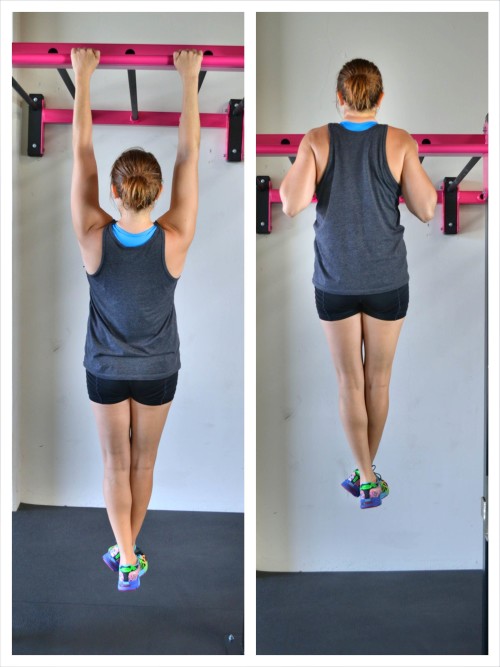
To do the Basic Pull Up, grab a pull up bar with your palms facing away and about shoulder-width apart. Changing your grip will work your back from different angles and potentially even make the move harder.
Then, hanging from the bar with your body straight, begin the pull up. Press your chest out and lead with your chest to pull your chin up above the bar. Drive your elbows down as you feel your shoulder blades draw down and together to help you pull up to the bar. Feel your back working to pull your chest up to the bar.
Once you get your chin above the bar, lower back down, fully extending your arms. Try not to swing a ton or kick to pull yourself up. Even control your pace lowering back down to the bottom.
Fully straighten your arms at the bottom of the Pull Up and then repeat, pulling yourself back up to the bar, leading with your chest.
For variations of the Pull Up, and even more back strengthening moves, check out this post on how to improve your Pull Ups.
Use these moves to reverse your rounded posture and forward flexion and improve your Thoracic Extension. Do not skip all of the four steps. Include foam rolling, stretching, activation and strengthening exercises to improve your Thoracic Extension and prevent and alleviate injury!
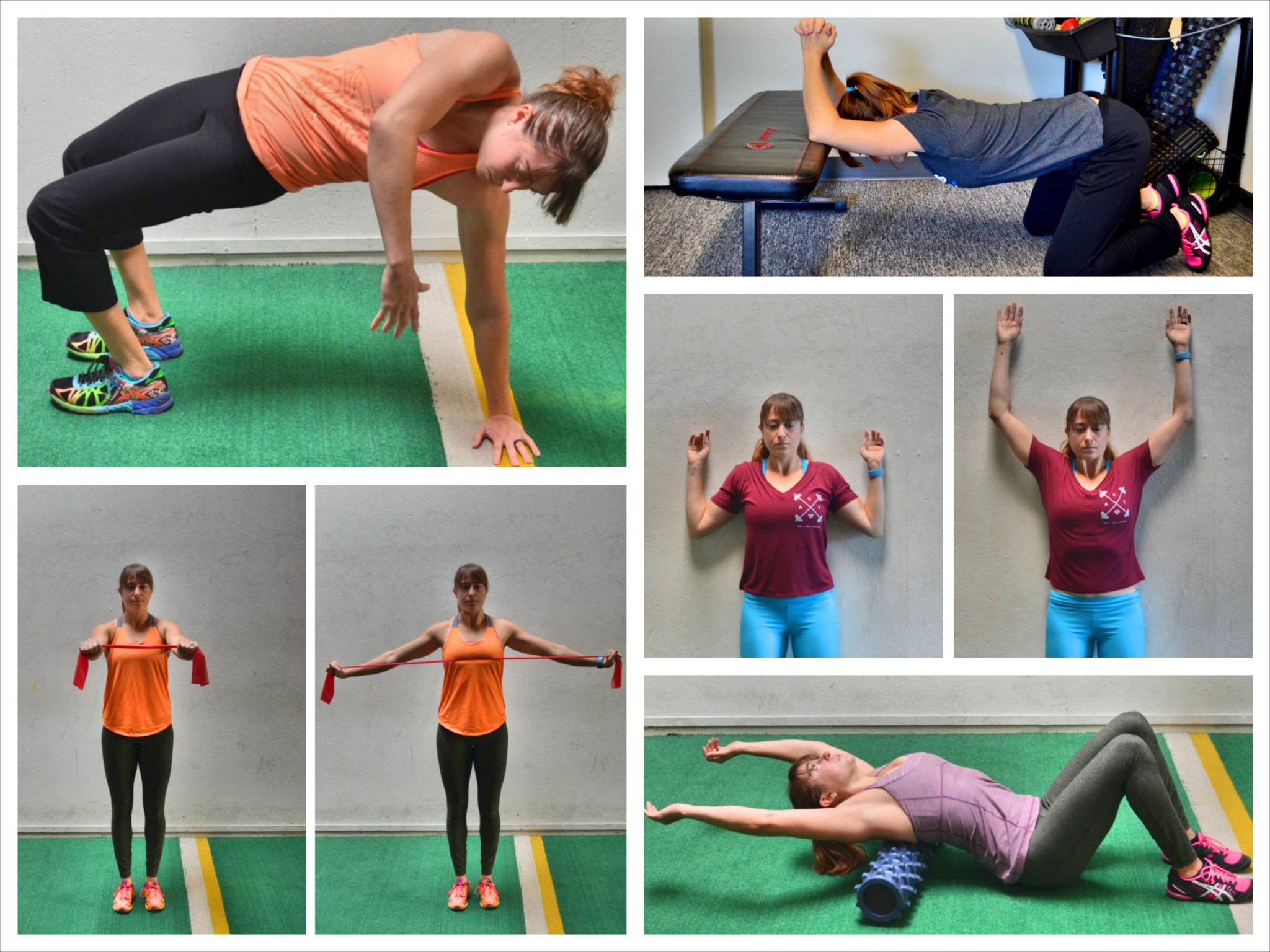
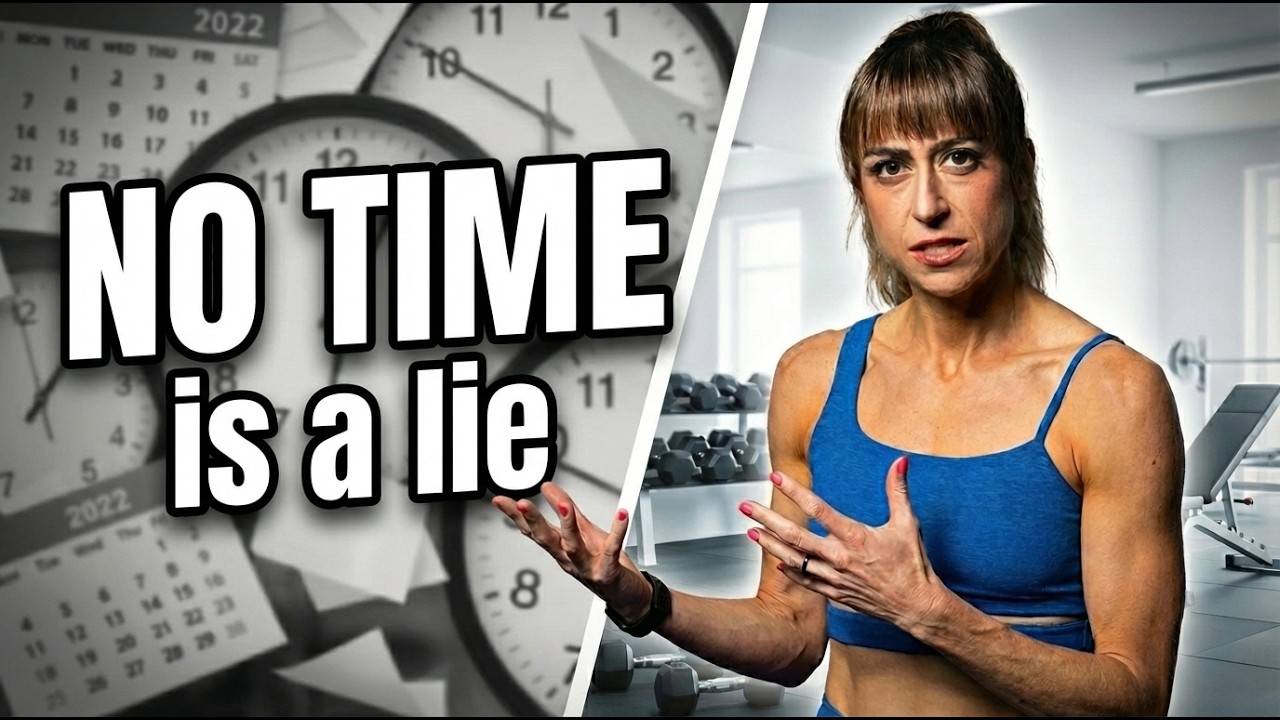
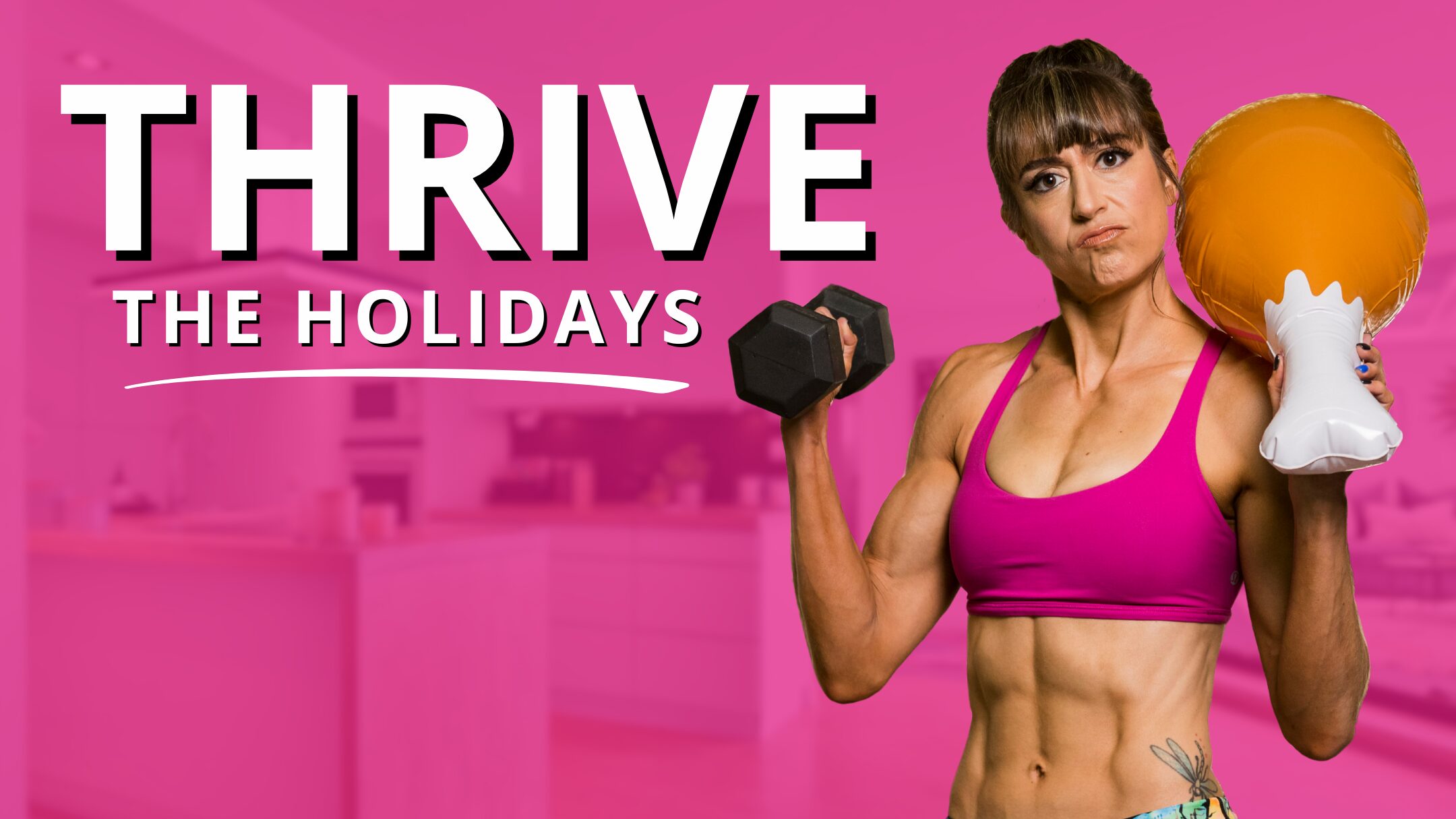
Great article an explanations!!!
Thanks!
Oh my god thank you so much!
🙂 Hope it helps!
Very good ! A lot a usefull informations, easy way to understand! Thanks!
Thanks!
I’m a few weeks into recovery after shoulder surgery. This is so helpful to me so thank you 🙂
Glad it helps! Take it slowly and remember once “better” rehab simply becomes prehab!
Excellent stuff as usual!
Thanks Zac!
This is excellent material!
How ofthen would you recommend doing this exercises for weightlifters?
Everytime before a upper body worktout?
Would you recommend doing all of the exercises or just a few of them?
I already use the wall slides and scapular band flyes.
I recommend before a lifting session always doing a short series of foam rolling, stretching and activation to make sure you relax tight muscles that may try to compensate and activate the muscles you want to do the work 🙂
Thank you for this. I have a curved spine from severe osteoporosis and I’m hoping these exercise will help straighten it again.
Do be careful with rolling if you have osteoporosis but the activation moves especially will be helpful!
This sequence was extremely helpful. I added band stretches for the lats, triceps and chest. It took me about 45 minutes to do the whole thing and plan to do it at least once a week on my rest day. My front rack position has to improve if I add some wrist flexibility stuff!
BTW….the thoracic bridge sit thru also helped me relieve all the gaseous matter in my intestine (maybe it happens to me only BUT you may want to be aware and avoid any social discomfort) 🙂
Glad it helped! And wrist mobility is more important than we realize especially if you spend lots of time at a computer!
Terrific series. Lots of respect and admiration for the language and the demonstration of each exercise.
Thanks William!
Thanks so much for this. I’ve suffered from sore back for a while snd this will help
So glad it helps!